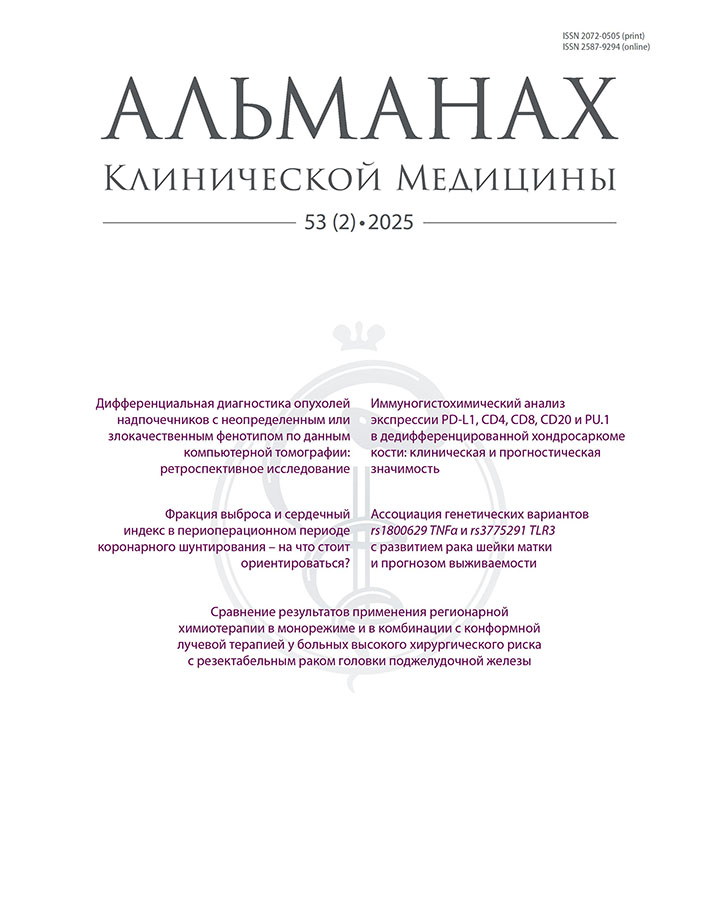Острая некротизирующая энцефалопатия детского возраста. Трудности диагностики и лечения в условиях пандемии COVID-19
- Авторы: Китаева В.Е.1, Котов А.С.2
-
Учреждения:
- ФГБОУ ВО «Московский государственный медико-стоматологический университет им. А.И. Евдокимова» Минздрава России
- ГБУЗ МО «Московский областной научно-исследовательский клинический институт им. М.Ф. Владимирского»
- Выпуск: Том 48 (2020): Спецвыпуск 1
- Страницы: 32-36
- Раздел: Статьи
- URL: https://almclinmed.ru/jour/article/view/1332
- DOI: https://doi.org/10.18786/2072-0505-2020-48-033
- ID: 1332
Цитировать
Полный текст
Аннотация
Острая некротизирующая энцефалопатия детского возраста (ОНЭДВ) возникает у ранее здоровых детей на фоне респираторной инфекции с лихорадкой, может проявляться эпилептическими приступами. На магнитно-резонансной томограмме (МРТ) обычно обнаруживаются двусторонние очаги поражения ствола мозга, мозжечка, таламусов, базальных ядер, белого вещества полушарий. Представляем три клинических наблюдения, первоначально диагностированных как ОНЭДВ. В первом случае у пациентки 12 лет на фоне лечения перинатального гепатита С пэгинтерфероном альфа^ отмечались головная боль, слабость в ногах и повышение артериального давления. Затем появились миоклонические приступы с переходом в эпилептический статус, тетрапарез, спутанность сознания, гипертермия. При биохимическом анализе крови уровень печеночных ферментов был повышен незначительно. При анализе спинномозговой жидкости определялось повышение белка. На МРТ обнаружено типичное для ОНЭДВ двустороннее поражение таламусов. Во втором наблюдении у пациента 1 года 5 месяцев после респираторной инфекции (рвота, ринит, лихорадка) на фоне гипертермии развились миоклонические приступы с переходом в эпилептический статус. На МРТ выявлены двусторонние поражения ствола мозга (дорсальных отделов моста), таламусов, подкорковых ядер, белого вещества полушарий головного мозга, а также поражение левого гиппокампа. Исследование спектра органических кислот в моче показало увеличение концентрации яблочной, 2-гидроксии-зовалериановой, 3-гидроксиизовалериановой, N-ацетиласпартатиковой, 3-гидроксимасляной и молочной кислот. По данным исследования крови отмечено увеличение концентрации показателей аланина, глутаминовой кислоты, глицина и орнитина. На момент обследования наследственная болезнь обмена веществ не выявлена. В третьем случае у пациентки 3 лет на фоне респираторной инфекции с рвотой, лихорадкой после падения с кровати развился левосторонний гемипарез. На МРТ определялось острое ишемическое повреждение. При анализе спинномозговой жидкости отмечен пониженный уровень белка. В настоящее время ОНЭДВ ставится как диагноз исключения. У третьей пациентки данный диагноз представляется ошибочным. Необходимо уточнение диагностических критериев синдрома и разработка протокола лечения пациентов с ОНЭДВ.
Об авторах
В. Е. Китаева
ФГБОУ ВО «Московский государственный медико-стоматологический университет им. А.И. Евдокимова» Минздрава России
Автор, ответственный за переписку.
Email: varvara-kitaeva@mail.ru
ORCID iD: 0000-0002-9334-8246
Китаева Варвара Евгеньевна - студентка 5-го курса лечебного факультета.
127473, Москва, ул. Делегатская, 20-1, Тел.: +7 (906) 086 68 70
РоссияА. С. Котов
ГБУЗ МО «Московский областной научно-исследовательский клинический институт им. М.Ф. Владимирского»
Email: alexeykotov1980@gmail.com
ORCID iD: 0000-0003-2988-5706
Котов Алексей Сергеевич - доктор медицинских наук, заведующий неврологическим отделением по разделу «Наука», профессор кафедры неврологии факультета усовершенствования врачей.
129110, Москва, ул. Щепкина, 61/2
РоссияСписок литературы
- Mizuguchi M, Abe J, Mikkaichi K, Noma S, Yoshida K, Yamanaka T, Kamoshita S. Acute necrotising encephalopathy of childhood: a new syndrome presenting with multifocal, symmetric brain lesions. J Neurol Neurosurg Psychiatry. 1995;58(5):555-61. doi: 10.1136/jnnp.58.5.555.
- Mizuguchi M. Acute necrotizing encephalopathy of childhood: a novel form of acute encephalopathy prevalent in Japan and Taiwan. Brain Dev. 1997;19(2):81-92. doi: 10.1016/s0387-7604(96)00063-0.
- Campistol J, Gassio R, Pineda M, Fernandez-Al-varez E. Acute necrotizing encephalopathy of childhood (infantile bilateral thalamic necrosis): two non-Japanese cases. Dev Med Child Neurol. 1998;40(11):771-4. doi: 10.1111/j.1469-8749.1998.tb12346x
- Ravid S, Topper L, Eviatar L. Acute necrotizing encephalopathy presenting as a basal ganglia syndrome. J Child Neurol. 2001;16(6):461-2. doi: 10.1177/088307380101600618.
- Kim KJ, Park ES, Chang HJ, Suh M, Rha D-W. Novel Influenza A (H1N1)-Associated Acute Necrotizing Encephalopathy: A Case Report. Ann Rehabil Med. 2013;37(2):286-90. doi: 10.5535/arm.2013.37.2.286.
- Ergul AB, Altug U, Aydin K, Guven AS, Altuner To-run Y. Acute necrotizing encephalopathy causing human bocavirus. Neuroradiol J. 2017;30(2): 164-7. doi: 10.1177/1971400916687586.
- Чучин МЮ. Острая некротическая энцефалопатия при вирусной инфекции. Детская больница. 2012;1(47):23-8. [Chuchin MYu.
- Горелик ЕЮ, Скрипченко НВ, Иванова МВ, Вишневецкая ЕМ, Глебовская ОИ, Попов ПА. Острая некротизирующая энцефалопатия -клинические наблюдения у детей раннего возраста. Инфекционные болезни. 2016;14(2):65-70. doi: 10.20953/1729-9225-2016-2-65-70.
- Denier C, Balu L, Husson B, Nasser G, Bur-glen L, Rodriguez D, Labauge P, Chevret L. Familial acute necrotizing encephalopathy due to mutation in the RANBP2 gene. J Neurol Sci. 2014;345(1-2):236-8. doi: 10.1016/j.jns.2014.07.025.
- Poyiadji N, Shahin G, Noujaim D, Stone M, Patel S, Griffith B. COVID-19-associated Acute Hemorrhagic Necrotizing Encephalopathy: Imaging Features. Radiology. 2020;296(2):E119-20. doi: 10.1148/radiol.2020201187.
Дополнительные файлы








